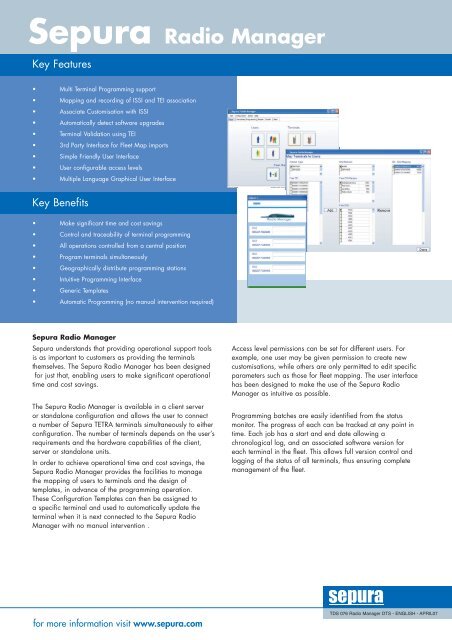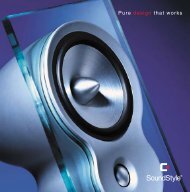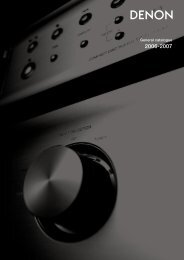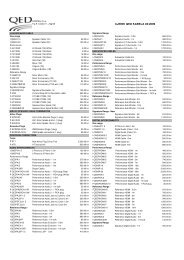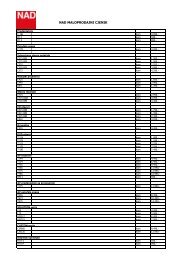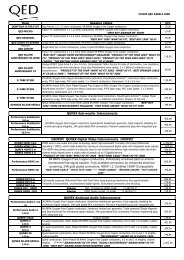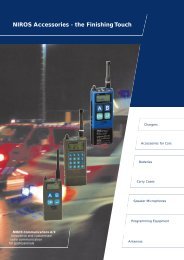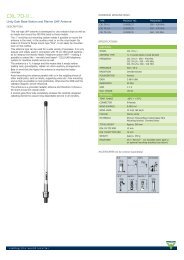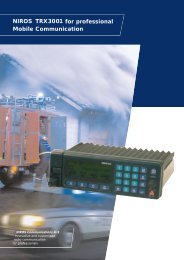Sepura Radio Manager - TETRA
Sepura Radio Manager - TETRA
Sepura Radio Manager - TETRA
Create successful ePaper yourself
Turn your PDF publications into a flip-book with our unique Google optimized e-Paper software.
<strong>Sepura</strong> <strong>Radio</strong> <strong>Manager</strong><br />
Key Features<br />
• Multi Terminal Programming support<br />
• Mapping and recording of ISSI and TEI association<br />
• Associate Customisation with ISSI<br />
• Automatically detect software upgrades<br />
• Terminal Validation using TEI<br />
• 3rd Party Interface for Fleet Map imports<br />
• Simple Friendly User Interface<br />
• User configurable access levels<br />
• Multiple Language Graphical User Interface<br />
Key Benefits<br />
• Make significant time and cost savings<br />
• Control and traceability of terminal programming<br />
• All operations controlled from a central position<br />
• Program terminals simultaneously<br />
• Geographically distribute programming stations<br />
• Intuitive Programming Interface<br />
• Generic Templates<br />
• Automatic Programming (no manual intervention required)<br />
<strong>Sepura</strong> <strong>Radio</strong> <strong>Manager</strong><br />
<strong>Sepura</strong> understands that providing operational support tools<br />
is as important to customers as providing the terminals<br />
themselves. The <strong>Sepura</strong> <strong>Radio</strong> <strong>Manager</strong> has been designed<br />
for just that, enabling users to make significant operational<br />
time and cost savings.<br />
The <strong>Sepura</strong> <strong>Radio</strong> <strong>Manager</strong> is available in a client server<br />
or standalone configuration and allows the user to connect<br />
a number of <strong>Sepura</strong> <strong>TETRA</strong> terminals simultaneously to either<br />
configuration. The number of terminals depends on the user’s<br />
requirements and the hardware capabilities of the client,<br />
server or standalone units.<br />
In order to achieve operational time and cost savings, the<br />
<strong>Sepura</strong> <strong>Radio</strong> <strong>Manager</strong> provides the facilities to manage<br />
the mapping of users to terminals and the design of<br />
templates, in advance of the programming operation.<br />
These Configuration Templates can then be assigned to<br />
a specific terminal and used to automatically update the<br />
terminal when it is next connected to the <strong>Sepura</strong> <strong>Radio</strong><br />
<strong>Manager</strong> with no manual intervention .<br />
Access level permissions can be set for different users. For<br />
example, one user may be given permission to create new<br />
customisations, while others are only permitted to edit specific<br />
parameters such as those for fleet mapping. The user interface<br />
has been designed to make the use of the <strong>Sepura</strong> <strong>Radio</strong><br />
<strong>Manager</strong> as intuitive as possible.<br />
Programming batches are easily identified from the status<br />
monitor. The progress of each can be tracked at any point in<br />
time. Each job has a start and end date allowing a<br />
chronological log, and an associated software version for<br />
each terminal in the fleet. This allows full version control and<br />
logging of the status of all terminals, thus ensuring complete<br />
management of the fleet.<br />
for more information visit www.sepura.com<br />
TDS 076 <strong>Radio</strong> <strong>Manager</strong> DTS - ENGLISH - APRIL07
<strong>Sepura</strong> <strong>Radio</strong> <strong>Manager</strong><br />
Connectivity Options<br />
System Requirements<br />
• <strong>Radio</strong> <strong>Manager</strong> can be run standalone<br />
• Remote Clients can be connected to a Server<br />
• Clients can be connected by LAN<br />
• Client Server Connection can be wired or wireless<br />
• Connect terminals to Client by:<br />
- Direct Physical Connection to Serial Port<br />
- Via USB<br />
- Via Serial Port Concentrators<br />
Please see www.sepura.com for the latest System Requirements<br />
TECHNICAL DATA<br />
Automatic Updates<br />
Records are maintained for each radio in<br />
the fleet, including the customisation and<br />
software version. When the fleet's<br />
customisation or software is required to be<br />
upgraded any radio presented to the <strong>Sepura</strong><br />
<strong>Radio</strong> <strong>Manager</strong> with an old customisation<br />
will be automatically upgraded. The user<br />
defines a programming batch which specifies<br />
customisation templates and software versions<br />
for radios within the fleet; and a start and<br />
end time. Any radio included in the batch<br />
and presented to a client within this time<br />
will be programmed to those specifications;<br />
real time remote reporting is available<br />
throughout this process.<br />
Terminal Validation using TEI<br />
The <strong>Sepura</strong> <strong>Radio</strong> <strong>Manager</strong> identifies a radio<br />
by its TEI. It will then look to see if an ISSI is<br />
associated with this TEI, if not it will<br />
(optionally) log the current ISSI against the<br />
TEI, or allocate a free ISSI. If an ISSI has<br />
been associated with a TEI within the <strong>Sepura</strong><br />
<strong>Radio</strong> <strong>Manager</strong> the Terminal will be<br />
customised with the ISSI if it has been<br />
scheduled for an upgrade.<br />
Multiple Terminal Programming support<br />
The <strong>Sepura</strong> <strong>Radio</strong> <strong>Manager</strong> will support up<br />
to 32 terminals connected simultaneously<br />
per client application. The restriction on the<br />
number of clients running on any one PC<br />
is limited only by the PC hardware<br />
performance. This facility will enable to<br />
make considerable savings, when updating<br />
terminals, both in time and resources.<br />
Interfacing to Fleet Mapping Applications<br />
A number of options are available for<br />
connecting the <strong>Sepura</strong> <strong>Radio</strong> <strong>Manager</strong> to<br />
a third party fleet mapping application:<br />
• An external spreadsheet containing Fleet<br />
Map data can be imported.<br />
• A third party fleet mapping application can<br />
be directly interfaced via a Fleet Mapping<br />
Application Programming Interface (API).<br />
User Configurable Options<br />
Access level permissions can be set within the<br />
programmer such that different users can be<br />
permitted to modify predetermined<br />
customisations. For example, one user may<br />
be given permission to create new<br />
customisations, while other users are only<br />
permitted to edit specific parameters within<br />
customisations.<br />
Templates<br />
Each customisation is created from a number<br />
of standard sets of parameters known as<br />
Templates. There are two types of templates,<br />
Standard Templates supplied by <strong>Sepura</strong>,<br />
which typically cover specific network<br />
suppliers, specific networks and a specific<br />
product, and Customer Templates created by<br />
the user. These customer Templates will apply<br />
to their specific tasks. These can be job<br />
specific or working group specific and<br />
typically contain fleet map information and<br />
user profiles (e.g. soft key mapping).<br />
Standard Configurations<br />
The <strong>Sepura</strong> <strong>Radio</strong> <strong>Manager</strong> is available<br />
in several configurations allowing the scale<br />
and cost point of the <strong>Radio</strong> <strong>Manager</strong> to<br />
reflect the needs of the end user. The<br />
<strong>Sepura</strong> <strong>Radio</strong> <strong>Manager</strong> is based upon<br />
3 standard configurations; each of these<br />
configurations can be enhanced by adding<br />
upgrade options.<br />
The <strong>Sepura</strong> <strong>Radio</strong> <strong>Manager</strong> consists of a<br />
software package and a licence to enable<br />
the activation of the required features. Each<br />
of the following product licences provides<br />
one of the three standard configurations of<br />
the <strong>Sepura</strong> <strong>Radio</strong> <strong>Manager</strong>:<br />
<strong>Radio</strong> <strong>Manager</strong> Lite<br />
Suitable for distributors or users with very<br />
small numbers of terminals.<br />
<strong>Radio</strong> <strong>Manager</strong> Standard<br />
Suitable for organisations who require multi<br />
terminal programming from a single location.<br />
<strong>Radio</strong> <strong>Manager</strong> Server<br />
Suitable for larger organisations who<br />
need to support the definition and control<br />
of programming centrally and execute at<br />
remote locations using <strong>Sepura</strong> <strong>Radio</strong><br />
<strong>Manager</strong> clients.<br />
© <strong>Sepura</strong> 2007<br />
<strong>Sepura</strong>’s policy is to continually improve its products and services. The features and facilities described<br />
in this document were correct at publication, but are subject to change without notice.<br />
TDS 076 <strong>Radio</strong> <strong>Manager</strong> DTS - ENGLISH - APRIL07


